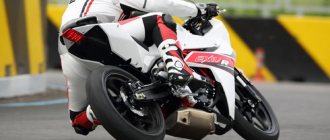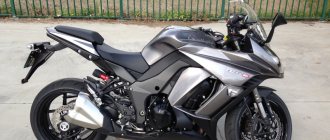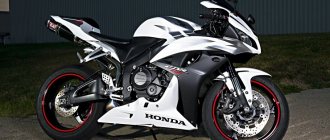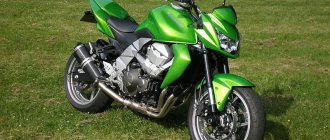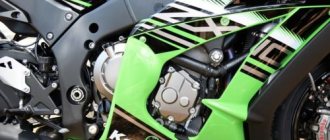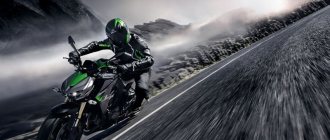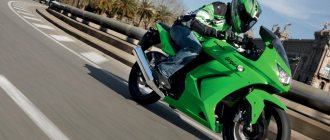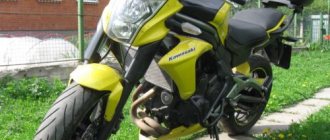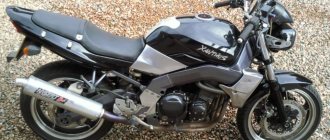RU-MOTO RATING
- Reliability
- Chassis
- Appearance
- Comfort
- Price
3.8
Verdict
- Stylish motorcycle for the city;
- High speed is combined with fast acceleration and handling;
- The owners do not identify clear weak points that are prone to breakdowns;
- Glass is often subjected to tuning, since the motorcycle has low wind protection;
- Stands out among competitors with better speed and acceleration
Read other motorcycle reviews Review of the Ducati Diavel motorcycle
2003 is the year of birth of the powerful, fast, but at the same time maneuverable Kawasaki z1000. Already at the time of its appearance, it was distinguished by a high displacement and had an original naked design. However, things can get even better. This series underwent changes in 2007, 2010 and 2014.
Motorcycle Kawasaki z1000
Although the Z1000 is positioned as a successor to the Z-series, which attracted millions of fans in the 70s, various elements from the ZX-6R and 6R were used in its creation. These models were released much later than the legendary Z-series - in the 90s.
001_MOTO_0910_014
Kawasaki Z1000: roadster, 2010, 1043 cm³, 138 hp, 221 kg, from RUB 516,468.
Kawasaki Z1000: roadster, 2010, 1043 cm³, 138 hp, 221 kg, from RUB 516,468.
Now a completely different type is held in high esteem. Down with prejudices and callous views! Choppers are for pot-bellied, bearded, overly well-fed and therefore unhurried gentlemen with an arrogant look. Of course, there are lovers of such characters, but how can I, young, slender, energetic, progressive and also modest, compare to them? Unless you can get somewhere a suspended silicone belly and a wig with the effect of “four hairs, but half a meter long.” Okay, let's leave chopperism to its apologists. Otherwise they will beat you to death with heavy leather jackets.
Owner reviews
On the forums and official websites of the Japanese manufacturer Kawasaki you can find more positive reviews about the Z1000 model.
The latest motorcycle models are characterized by a clearly functioning suspension and an adequate response to the pilot’s actions.
However, there are several negative reviews about this prototype, mainly related to its appearance and all-electronic display. But this applies more to models from 2010 to 2013. release _ But nothing bad can be said about the first samples.
003_MOTO_0910_014
15-liter tank for a “kilogram” - two sips.
More precisely 200 km, if you don’t burn too much. The tiny size of the “slapper” for the passenger, apparently, should be compensated by the euphoria from the beauty of the motorcycle. 15-liter tank for a “kilogram” - two sips. More precisely 200 km, if you don’t burn too much. The tiny size of the “slapper” for the passenger, apparently, should be compensated by the euphoria from the beauty of the motorcycle.
005_MOTO_0910_014
The “glass” is also purely stylistic, it is of absolutely no use.
The “glass” is also purely stylistic, it is of absolutely no use.
So, the social-motorcycle experiment ended with quite logical results: most of the interested glances I collected (and a couple of easy but promising acquaintances) belonged to young ladies, energetic and athletic (as evidenced not only by the style of clothing, but also by all kinds of rollerblades, bicycles and other bags with tennis rackets). Yes, if it weren’t a “Zedka” standing next to my table, but some kind of “chrome truck”, I would have collected only punk teenagers and bored ladies of Balzac’s age... Although I still won’t draw parallels, I’ll focus on the motorcycle. The updated, or rather practically brand new, Kawasaki Z1000 has really taken another leap forward from “just a classic” to an “evil naked”. In all respects, it can be safely classified as a street fighter. She seems to be a spiteful woman, but somehow amazingly noble. The facings, painted in white mother-of-pearl with red accents, are set off by a black frame and engine with absolutely cosmic outlines. The picture is completed by a mega-brutal front fork, entirely hidden in a rectangular plastic casing. It seems that one of the key conditions for creating the appearance of the bike was the ban on the use of compasses. Just a ruler and a square! And of course, the last chord that finally attracts the eye to the bike is the mufflers. “Zedki” of previous generations, it should be noted, were also distinguished by “pipe modernity,” but here the designers simply outdid themselves. And how does the device look in metallic chestnut brown color and with a “seat” covered with “python skin”! In general, the appearance of the device is brutal, masculine and noble. What can you do, but it’s very difficult to get away from the usual nicknames “Zedka” and “Kava”. So I won’t bother inventing male names, but remember that this “Kava” is quite a “man”.
First impressions of the motorcycle turned out to be very vague. It seems to be an “evil” naked bike, but to say that the landing “provokes annealing” does not work at all. It is quite comfortable, with a slight tilt forward and, again, a slight shift of the footrests back and up. The fairly wide, almost cross-shaped steering wheel only aggravates this feeling. “I sat down and went to the bakery to get some buns for tea.” The motor behaves in approximately the same manner as the ergonomics. Grumbling softly with two twin mufflers, the device smoothly accelerates without any jerks, explosions or attempts to stall at low throttle, so characteristic of highly accelerated engines. He is absolutely controlled, predictable and adequate in his reactions. A completely smooth torque characteristic is largely achieved due to significant “squaring” of the engine. Compared to the previous generation Z1000, the cylinder diameter decreased from 77.2 to 77 mm, and the piston stroke increased from 50.9 to 56 mm. This “de-extreme” dimension, coupled with the reconfiguration of the injection and exhaust systems, gave the motorcycle a “tractor” characteristic. Throughout the entire rev range, I was unable to feel any significant dips or pick-ups. The device accelerates very smoothly and very powerfully. Honestly, I can't even categorize it clearly. He is both “low-level” and good in the middle, and doesn’t fade away at the “top”. Some kind of completely “electric” motorcycle.
The suspension is “trained” to work in the same confident, dense, but soft manner. Even residents of cities with not very favorable asphalt conditions will not have to buy panties with additional capacity for a crumbling spine. The Z1000 is equipped with a full arsenal of adjustments, so with a certain skill in noticing especially “criminal” potholes in advance, you can generally feel no worse than other “hungry drinkers” in the city. With all this softness on the race track, the motorcycle does not show the slightest bit of “sloppyness”, “floating” off trajectories or instability in corners. I note that during the test, both in the city and before the karting races, I did not “wind up” the suspension. The factory settings in both cases completely suited me, but the very awareness of the possibility, if necessary, to “tighten” or “loose” was simply pleasant.
Price
The price range for the Kawasaki Z1000 is quite wide. The cost is determined based on the year of manufacture, equipment, and condition of the bike (if we are talking about a used motorcycle).
A new Kawasaki 2022 from a dealer costs about 900,000 rubles. The 2022 model can be picked up from the showroom for about 850,000 rubles. For the new R Edition you will have to pay 980,000 rubles.
Much more affordable prices for used offers. Version 2007 can be purchased for 360,000 rubles. in good condition with about 20,000 km mileage. For 510,000 rubles. you can become the owner of the 2011 version without an accident, but with tuning.
Those who want to ride one of the best stripfighters and are ready to buy a used version should pay attention to the natural wear and tear of the motorcycle. If the bike was used on Russian roads, the condition will be much worse than that of an iron horse that has never traveled outside its homeland; in this case, Japanese motorcycle auctions will help solve the problem. You can view auction prices for this model here.
013_MOTO_0910_014
The geometry of the device was also chosen to match the “overall sound”. The control acuity in it is sufficient for karting, twisted turns, and for aggressive “embroidery” in traffic jams, but at the same time, the motorcycle does not yaw, does not break in turns, does not resist rolls, and certainly does not allow itself to buck on uneven surfaces. , longitudinal waves and other nasty things on the road surface. On the track, “Zed” allows you to lay yourself down to quite “adult” knees, and quite quickly and without much effort on the part of the pilot, at least by roadster standards, shift yourself in bunches of turns. At the same time, it does not bother you at all with excessive agility during calm and even measured movement along the streets. Yes, this motorcycle is capable of not only “burning” like an adult, but also just driving, and driving slowly! That's what you don't expect from a device with such appearance and performance characteristics! The only thing, perhaps, this motorcycle is not given is to shoot quickly on the highway. No, of course, there is enough “stupidity” in it for both “kopeck piece” and “kopeck piece”, but with its complete lack of wind protection, it’s simply impossible to go faster than 130–140 for any length of time. Even a trained wrestler’s neck will only last a couple of kilometers at most. Although if you really “light up” at the karting track located outside the city, and then slowly ride home, inhaling the evening air and watching the reaction of the young ladies on foot, it will be very pleasant.
In general, the motorcycle is very similar to a sambo wrestler. The trained body is filled with strength, the gait is soft but elastic. He is relaxed and friendly, but at any moment he is ready to “shoot” like a loose spring, and then the offender will be in trouble! These are the kind of comrades that young ladies like. Of course, he has muscles, and some others, but he doesn’t flaunt them, but he literally radiates confidence, reliability and safety, and this is what women of any age value above all else. “Zed” is exactly like that. Handsome, “muscular”, stocky, but not like a “varnished” bodybuilder, who is only useful to watch on TV, but a real one, radiating real, noble strength. And against the backdrop of “anabolic” sportbikes and “elderly” choppers, this advantage is especially noticeable.
Dashboard
The first models were equipped with a “tidy” with a pointer-type tachometer.
On the simplest examples of the Japanese sports motorcycle, produced until 2010, a dashboard was installed consisting of:
- round dial of a pointer type , with a maximum value of 13 thousand rpm .
- Rectangular LCD display displaying the speed of the bike and its actual mileage.
- Several light indicators showing: the current gear of the gearbox, the turn signal and high beams on, oil pressure, exceeding the maximum permissible speed, and the state of the engine (Check-engine).
Intermediate version of the panel.
Modern option.
Depending on the year of production of the model, the design of the dashboard changed significantly, and only on the latest samples the dial was replaced with an electronic engine speed indicator.
004_MOTO_0910_014
As an inveterate endurist, it was even a little scary for me to get on this motorcycle.
A bunch of “horses”, “evil” geometry, low ground clearance and an outwardly complete inability to overcome even the smallest potholes. Just show-off and a bow on the side with complete lack of viability together. However, the motorcycle actually turned out to be, above all, very practical. But isn’t this the main thing if a motorcycle is bought specifically for riding, and not for an exhibition stand? Although “zed” will not save you in the spotlight. As an inveterate endurist, it was even a little scary for me to get on this motorcycle. A bunch of “horses”, “evil” geometry, low ground clearance and an outwardly complete inability to overcome even the smallest potholes. Just show-off and a bow on the side with complete lack of viability together. However, the motorcycle actually turned out to be, above all, very practical. But isn’t this the main thing if a motorcycle is bought specifically for riding, and not for an exhibition stand? Although “zed” will not save you in the spotlight.
History of changes
During its rather long journey, the bike has already gone through several stages:
- 2003 – first generation;
- 2007 – major update, including a change in the exhaust system;
- 2010 – second generation, numerous changes;
- 2011 – Z1000SX version appeared;
- 2014 – reconfiguration of the engine, as well as changes to the chassis.
The bike has looked different over the years, but overall it has always been a serious machine that challenges the traditional naked bike class.
015_MOTO_0910_014
Technical characteristics of Kawasaki Z1000 (manufacturer data)
| COMMON DATA | |
| Model year | 2010 |
| Curb weight, kg | 221 (218 kg without ABS) |
| Seat height, mm | 815 |
| Gas tank volume, l | 15,5 |
| ENGINE | |
| Type | R4, 4T |
| timing belt | DONS |
| Working volume, cm³ | 1043 |
| Cylinder diameter × piston stroke, mm | 77×56 |
| Compression ratio | 11,8 |
| Max. power, hp at rpm | 138/9600 |
| Max. torque, Nm at rpm | 110/7800 |
| Supply system | fuel injection |
| Cooling system | liquid |
| Starting system | electric starter |
| TRANSMISSION | |
| Clutch | multi-disc, oil bath |
| Transmission | 6-speed |
| main gear | chain |
| CHASSIS | |
| Frame | diagonal, aluminum alloy |
| Front suspension | inverted dip telescopic fork, fully adjustable, tubes ∅ 41 mm |
| Wheel travel, mm | 120 |
| Rear suspension | monoshock absorber, fully adjustable |
| Wheel travel, mm | 135 |
| Brake system | separate, hydraulic, with ABS (optional) |
| Front brake | 2 petal discs, ∅ 300 mm, 4-piston radial calipers |
| Rear brake | 1 disc ∅ 250 mm, 1-piston floating caliper |
| Wheels | cast, aluminum alloy |
| Front tire | 120/70ZR17 |
| Rear tire | 190/50ZR17 |
The motorcycle was provided by the Kawasaki Center-West showroom.
The track part of the test was carried out at the Mayak karting track.
Other type: Kawasaki Z1000
Exterior of Kawasaki Z1000
From the very beginning of production, the Z1000 was positioned as a road-class motorcycle.
The very first Kawasaki Z1000 models (2003–2006) already had a rather stylish look, characteristic of the sports class of motorcycles of that time.
Thoroughbred steel horse.
Side view.
Front view.
Back view.
- the front , with a headlight and tinted windshield that have a lot of sharp corners and sharp bevels. The turn signal indicators are placed separately for better visual perception, and above the front wheel the designers installed a massive wing that protects the driver from water and dirt during bad weather.
- On the side of the motorcycle you can find a minimum of plastic elements. The engine, gearbox cover, radiator, and dual exhaust pipe have open access; at the very top of the technical filling there is a volumetric tank made in the shape of a semicircle with sharp bevels. The driver and passenger seats are separated and installed at different heights. At the same time, the factory version of the bike has a plastic cover under which you can hide the rear seat in case of a solo trip.
- There is also nothing superfluous at the rear of the Kawasaki Z1000 . A small brake light of an unusual angular shape is hidden under the plastic lining of the seats. And underneath there is a separate mount for the license plate (not on the wing, as on many Japanese models, but on three individual brackets).
First restyling
After the first restyling, carried out in 2007, the motorcycle changed somewhat in appearance.
And the first thing that catches your eye is the presence of additional pads on the sides, onto which the designers moved the turn signal indicators.
Side fairings appeared at the front.
The rear mufflers have changed.
Also, to resemble a sports bike, the updated model was made more planted, and its front facing was significantly sharpened.
After 2010
The bike began to look more aggressive.
New plastic design.
Engine of increased volume.
New exhaust system.
The next version of the Kawasaki Z1000, developed in 2010, had minimal visual differences from the previous prototype, and all the manufacturer’s efforts went into technical improvement of the bike.
As a result of such improvements, the Z line was replenished with the flagship model Z1000SX Ninja, equipped with full-fledged LED optics and quite powerful hardware.
